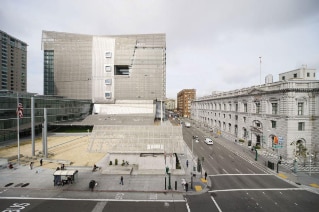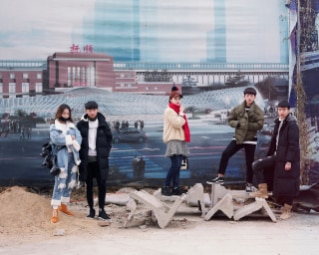Once again, halfway through writing an Op-Ed, a catastrophic flood punishes the earth. The Fukushima tsunami washed over Abstainability, a text I wrote for domusweb in 2011. Now Sandy has purged some of my thoughts on adaptive reuse.
Originally intent on writing about how we, in the pursuit of a "timely" architecture, contemplate sites saturated with extant "stuff" — mostly parts that once aggregated to a near whole — I had drifted towards pondering world heritage, Metabolism and other grand themes. Then Sandy threw me back to more quotidian contexts, the "stuff" we deal with on a daily basis but never give the consideration it might deserve.
After the recent Frankenstorm hit New York, our screens were once again filled with imagery of humanity's muck swept away by the sea — decrepit roller coasters, rotten boardwalks, corroded pergolas, dilapidated siding, shattered shutters — the junk our current world produces and values. Much was lost, but remarkably enough, the damage to commerce and wealth caused by the storm will probably be balanced out by the money that will go into reconstruction and recovery efforts. And the material loss of this "stuff", already written off prior to the storm, will not show up in economic data, whereas its reproduction will. Undoubtedly some will note the irony that destruction is a means of growth, a creative force.
In an accelerating world, creative destruction strips increasingly more constructs of their cultural meaning, and at an increasingly rapid pace — be it due to natural or economically volatile conditions. These forces leave their mark. One can argue that this is not a new condition. For centuries architects working in cities have dealt with historic settings. But now the remnants of previous occupants are not the prized relics of past civilisations — part of the "12 per cent preservation regime", as termed in Cronocaos by AMO. Instead, the growing pile of leftovers amount to just plain stuff: walls, pipes, struts, lintels and cornices. Moreover, sites come not only with material residue but also emotional baggage: endearing vistas, semi-successful symmetries, idiosyncratic portals, little design adjustments, site conditions, aspirations gone awry.
This physical debris comprises our unedited legacy, history and identity — the gunk that actually fills up cities is our real heritage. How to engage with this filtrate of human intentions? One can evaluate its reuse from an economic position, or as a carrier of embodied energy — so as not to be wasteful. These approaches seem commonplace, leading to well-articulated ideas of "harvesting" or "mining"' cities and sites. This kind of analysis might give us some clues, but I would rather set aside the quantifiable here, and contemplate an imaginary landscape with architectural qualities, enriched through its negotiation with the "stuff" that is already there.
From this perspective let us consider the competition for the renovation and extension of Z33, an institute for contemporary art in Hasselt, Belgium, as it illustrates the diverse approaches of five contemporary practices when taking on found "stuff". Located in the highly commercialised centre of this medieval Flemish town, the Z33 site is particularly full of such stuff, including the remnants of a bombed-out cathedral, deliberately left in ruins as a lesson from the past; a reconstructed "historic" beguinage convent; an architecturally weak but typologically significant exhibition building dating from 1958 (the Vleugel '58); and a retro-style brick-covered school built in the 1980s. The competition consisted in rethinking and extending the Vleugel '58 wing to house a revamped Z33.
The attitudes of the teams cover a wide range of positions. XDGA is bold and unsentimental towards the historic, placing a machine-like tower in the middle of the courtyard. Junya Ishigami and MAKS unleash a "tsunami" of brick that plays a subtle game between the contextual and the innovative. The group consisting of Francesca Torzo, Aldo Bakker, Piet Oudolf and ABT offers a morphological and poetic validation.
De Vylder Vinck Taillieu harvests the site in an irreverent manner, reusing the faux-historic school. SO – IL's scheme, titled Filter, uses the idiosyncratic relation between wall and opening in the hyper-elemental existing building as an alibi for the project, as well as the somewhat clumsy yet endearing organisation of the rooms. The scheme transforms the existing building, but then uses that transformation to situate and frame the new building. Old and new are interdependent, but neither reproduces the old or the nostalgic.
It is indicative of our times that the romantic prevailed in the competition. We are at an impasse. Ours is a period of sentimentality and nostalgia. Ideals are obsolete, classical orders and form no longer hold meaning and we lack the clarity of previous decades. Sensing that linear history is over, we long for "authenticity" in a seemingly spiritless life — an authenticity that once was, but now seems to have evaporated. We re-enact heroic conceptual architectures from the '70s, dabble in ruin porn, revive prewar building styles, or literally reconstruct historic edifices such as the Berliner Stadtschloss or Frankfurter Rathaus. Despite these trends, there appears to be little discussion, or critical consideration, on how to deal discursively with all that old and ageing stuff that surrounds us. Interest in historical styles, sentimentality and nostalgia is mostly representational. What appears to have been left out of this conversation is architecture — space, form, tectonics, etc.
Does our inability to find a coherent attitude for tackling the past relate to our blank attitude regarding the future? Where architecture used to be a search for the unknown, it is now a passive acceptance of the seemingly appropriate. Where architectural post-modernism evoked historicist symbols with the intent of moving the profession forward, it seems that now we are unwittingly fishing out of the historic pond, be it modern or retro. Could the existing not be the instigator or catalyst of the new? Can it trigger new relationships, intensifying our subjective experience of space?
Tabula rasa is for cowards, but there are no coherent rules for playing the game on a board filled with pieces. With this in mind, I propose the first rule: challenge what is there, reactivate it, make it part of the current, but allow it to cause friction, to resist. The moment we let go of sentimental values, but holistically assess what is there, and have it fight for its place in the here and now, we can re-endow the old with contemporary architectural agency. Florian Idenburg (@florianidenburg) is a New York-based architect engaged in practice and academia. He is cofounder of the architectural practice SO – IL and Adjunct Assistant Professor at Harvard GSD.







